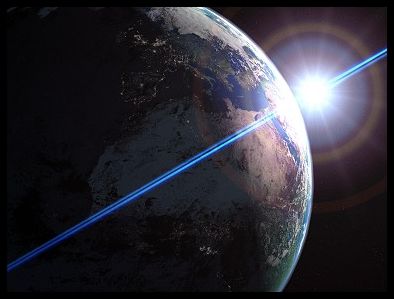
Worked Example
A0 Star
Luminosity = 63 times the luminosity of the Sun
Scale from the Sun's habitable zone
Inner edge = 6.72 AU
Outer edge = 13.6 AU
Width= 6.88 AU
Worked Example
M8 Star
Luminosity = Luminosity = 0.008 Sun
Inner edge = 0.075 AU
Outer edge = 0.152 AU
Width= 0.077 AU
Habitable Zone is wider and further away for more massive stars
Lifetimes
Why do stars shine?
Stars shine because they are hot.
--Emit light with a roughly thermal (blackbody) spectrum
--Internal heat "leaks" out of their surfaces.
Luminosity = rate of energy loss
To stay hot, stars must make up for the lost energy, otherwise they would cool and eventually fade out.
Generate energy by "burning" H into He in its core.
Fusion Energy
Fuse 1 gram of Hydrogen into 0.993 grams of Helium.
Leftover 0.007 grams is converted into energy
Hydrogen Fusion
Equivalence of mass and energy
Issues:
-- Four hydrogen nuclei fuse into one helium nucleus,
and the remaining 0.7% of the mass is converted to energy.
Stars overall lose a very small amount of mass (only about 0.07%).
Case Study: The Sun
Question:
How long can the Sun shine?
Need two numbers:
--How much internal heat there is in the Sun.
--How fast this heat is lost (Luminosity).
The Nuclear Lifetime
The nuclear lifetime is
 f = fraction of nuclear fuel available for fusion
epsilon = efficiency of matter-energy conversion
M = mass; L = luminosity
For the Sun:
lifetime = 10 Gyr if f=10% of the Sun's H burned into He with epsilon=0.7% efficiency
f = fraction of nuclear fuel available for fusion
epsilon = efficiency of matter-energy conversion
M = mass; L = luminosity
For the Sun:
lifetime = 10 Gyr if f=10% of the Sun's H burned into He with epsilon=0.7% efficiency
Lifetime as a function of Mass



Examples:
Sun:
M = 1 Msun, ?MS ? 10 Gyr
Massive Star (10 Msun)
Lifetime ~ 10 Gyr/1000 ~ 10 Million Years
Low-mass Star (0.1 Msun)
Lifetime ~ 10 Gyr / 0.001 ~ 10 Trillion Years
Consequences:
If you see an O or B dwarf star, it must be young as they die after only a few Million years.
M dwarfs live a long time and age slowly.
The Sun is ~ 5 Billion years old, so it will last only for ~ 5 Billion years longer.
Definition: Stars which generate energy by fusion of H into He
The Main Sequence is a Mass Sequence
The location of a star along the M-S is determined by its Mass.
--Low-Mass Stars: Cool & Low Luminosity
--High-Mass Stars: Hot & High Luminosity
Result of the Mass-Luminosity Relation:

Planet Formation Timescale
Timescale for planet formation is very uncertain
But probably at least ~10 million years
Late Bombardment on Earth lasted for ~500 million years
Stellar lifetimes of at least 500 million years.
Lifetime Constraint
Ages greater than 500 million years
--> Masses less than ~3 Solar Masses
Excludes O and B type stars.
Brighter with Age?
M-S stars get slowly brighter with age.
Small effect: the sun has gotten 30% brighter in 4.5 Gyr
High mass stars get brighter faster
Low-mass stars have more stable, long-lived habitable zones.
Other Considerations
Tidal Locking: Bad for Habitability?
Closer planets may be tidally locked
One side of the planet gets all the radiation
Too Hot Side/Too Cold Side
Requires atmosphere to redistribute heat
Which stars have tidally locked planets in the habitable zone?


Habitable Zones orbiting M dwarfs are tidally locked!
Flares and UV radiation?
M stars have flares
--Flares are enormous outbursts of high-energy (X-ray and UV) radiation
--Could potentially be sterilizing
--On the contrary, may stimulate evolution
High mass stars emit lots of UV radiation
--Similarly could be good or bad for life.
See A Note about Graphics to learn
why the graphics shown in the lectures are generally not reproduced with
these notes.
[
Return to the Astronomy 141 Main Page
|
Unit 4 Page
]
Copyright © Scott Gaudi All Rights
Reserved.










